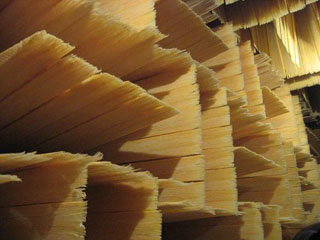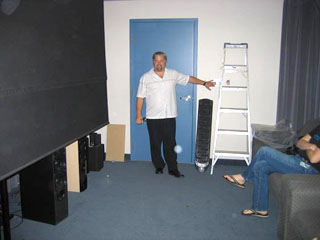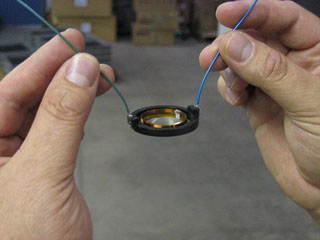 Letís
Start at the Beginning: Design
Letís
Start at the Beginning: Design
The measurement and software capabilities used by Paradigm in loudspeaker
design are truly impressive. With the immense and troublingly quiet anechoic
chamber, the automated microphone height and loudspeaker swivel mechanism,
the software generates the test signals, controls the microphone/loudspeaker
relationships, and analyzes the results. This is a tremendous advantage.
Paradigm can very quickly get a thorough and precise idea about what a
loudspeaker is doing in a matter of minutes in all directions, not just
on-axis. Looking over the design engineerís shoulder, I nearly drooled on
his mouse looking at multiple frequency response plots vs. angle, total
power response plots, yadda yadda. I wish we could have this setup for
Secrets in several locations, one of them being on the couple of empty acres
next to my house. I donít know of any audio/video publication that has near
this degree of measurement capability and finesse, and have a feeling that
you could count the total number of loudspeaker manufacturers in the entire
world with this kind of capacity on your fingers, perhaps not even using
your thumbs.
 So
what? While the software they wrote for themselves can do crossover and
driver modeling to predict a result just like other off the shelf software
design solutions available, there is no substitute for verifying the
reality. Efficient and thorough measurements enable a better product for
less money. If you catch a problem before the listening session process, you
save time that would otherwise be wasted (and expensive.) If you measure
quickly, you reduce the costs as well. If you donít measure thoroughly,
you're in for a far more extended, far less effective, trial and error
process.
So
what? While the software they wrote for themselves can do crossover and
driver modeling to predict a result just like other off the shelf software
design solutions available, there is no substitute for verifying the
reality. Efficient and thorough measurements enable a better product for
less money. If you catch a problem before the listening session process, you
save time that would otherwise be wasted (and expensive.) If you measure
quickly, you reduce the costs as well. If you donít measure thoroughly,
you're in for a far more extended, far less effective, trial and error
process.
The advantage of being able to actually measure and then analyze the end result
thoroughly and quickly compounds with every iteration of testing. Testing is
not something done just once to verify that a design is correct. It's part
of the process itself. Design, test, modify, re-test, modify, etc. If you
canít test thoroughly, turning out a good product not only becomes much more
difficult and time-consuming, but youíll likely send a few dogs into actual
production.
 Once
you've got a design that measures the way you want it to, in the same way
that thereís no real substitute for thorough, real measurements, thereís no
real substitute for thorough, unbiased, listening evaluations. Paradigm uses
two rooms for blind listening evaluations used in developing their products.
One, shown at the right (that's Mark Aling by the door), emulates the acoustics of a typical living room, a bit on
the 'live' side, while the other simulates a dealer showroom with heavy curtains
that can be moved around to replicate different setups.
Once
you've got a design that measures the way you want it to, in the same way
that thereís no real substitute for thorough, real measurements, thereís no
real substitute for thorough, unbiased, listening evaluations. Paradigm uses
two rooms for blind listening evaluations used in developing their products.
One, shown at the right (that's Mark Aling by the door), emulates the acoustics of a typical living room, a bit on
the 'live' side, while the other simulates a dealer showroom with heavy curtains
that can be moved around to replicate different setups.
It's interesting that they don't use dedicated sound rooms with lots of absorption or
diffusion. While a dedicated, acoustically optimal room would be the best
scenario for getting the 'best' listening experience, it doesn't tell you
how speakers sound in scenarios more akin to the 'real world'. As Dr. Floyd
Toole (now a Harman employee) showed through listening research conducted
with the NRC, the best speakers for 'real world' listening are those
designed with smooth, even, and consistent frequency response in many
directions, not just a flat frequency response on-axis (though you'd want
flat response on-axis too.) And, of course, speakers that work well in a
'regular' living room only get better when you put some effort into treating
the room itself. Since Paradigm's design and measurement facilities cater to
just this, you'd think theyíd be pretty close to begin with. Using realistic
listening environments for product development testing just makes the whole
process more sensible, efficient, and relevant.
After designing your loudspeaker of choice, it's a whole other matter of
making more of them, lots more. While many manufacturers OEM pretty much all
of their parts (drivers, cabinets, electronics), Paradigm makes just about
everything from scratch. Well, they buy capacitors and resistors and wire,
but you get the idea. There is an exception, the cabinets for their
Signature Series loudspeakers. They simply cannot make the curved enclosures
with their own facilities while keeping the cost reasonable. I found this at
first a bit funny, though it did show that they were committed to results,
not ideology. If something works better for them, they'll do it.
And itís not like outsourcing the production of parts is necessarily a bad
thing. It lowers your manufacturing overhead, which makes you more flexible
from a cash flow standpoint. For relatively small or medium-sized
manufacturers, there isnít enough volume to justify making everything
yourself. However, it does put you at the mercy of your suppliers, and it
requires either meticulous inspection (and rejection) of the sub-assemblies,
and for a given level of consistency, ups your quality control costs, as you
have to go back and find other peopleís mistakes.
Itís not that thereís necessarily a right way of manufacturing, but Paradigm
makes a good argument for doing as much as possible in house, particularly
when manufacturing on a very large scale.
 I
watched a lady making voice coils one at a time. With a machine, she wrapped
a whole bunch of wire around a former quickly and exactly. I think she
deserved a raise! Mark claimed that the industry standard for voice coil
windings is Ī half a turn. They do
Ī zero. Any manufacturer who buys
drivers from someone else can certainly deliver great products, perhaps even
designing the drivers themselves to be built to spec, but they certainly
canít be so meticulous in guaranteeing the quality of the finished product
through inspection after the fact without actually destroying the drivers in
the inspection process. If you make the drivers yourself, you can make sure
that the parts are right before they become part of a woofer or tweeter . .
.
I
watched a lady making voice coils one at a time. With a machine, she wrapped
a whole bunch of wire around a former quickly and exactly. I think she
deserved a raise! Mark claimed that the industry standard for voice coil
windings is Ī half a turn. They do
Ī zero. Any manufacturer who buys
drivers from someone else can certainly deliver great products, perhaps even
designing the drivers themselves to be built to spec, but they certainly
canít be so meticulous in guaranteeing the quality of the finished product
through inspection after the fact without actually destroying the drivers in
the inspection process. If you make the drivers yourself, you can make sure
that the parts are right before they become part of a woofer or tweeter . .
.
Click Here to Go
to Part III.